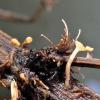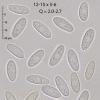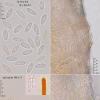
06-12-2025 00:19
 Viktorie Halasu
Viktorie Halasu
Hello, would anyone have this article, please? An

05-12-2025 17:33
 Bruno Coué
Bruno Coué
Bonjour, je serais heureux de recueillir votre avi

02-12-2025 18:59
This pair of ascos 2.5cm across were on recently b

02-12-2025 19:25
Buckwheat PeteHello, can anyone identify this hairy fungus growi

30-11-2025 12:53
 Edvin Johannesen
Edvin Johannesen
White short-stipitate apothecia found on thin twig

30-11-2025 10:47
 William Slosse
William Slosse
I recently found a collection of small Peziza sp.
Hi again
Could you help me with this yellow, long stipitate, Hymenoscyphus growing in a peat bog, on Rumex sp. old stems at 1700 m of altitude? Spores allipsoid with very low oily content. Asci up to 140 x 11, IKI b of the Hymenoscyphus-type, 8-spored, arising from croziers. Paraphyses with yellow, multiguttulate VBs. Excipulum with no globulosa or angularis tissue.
I don't find any species that fits well with this collection
Thanks again

Did you look at the two left fruitbodies, are they senescent or do they contain conidia? (to be sure that it is no Symphyosirinia).


